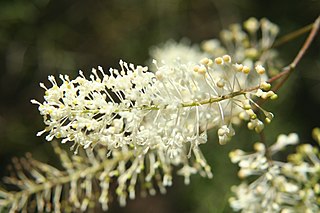
Grevillea leptopoda is a species of flowering plant in the family Proteaceae and is endemic to the south-west of Western Australia. It is a spreading to erect shrub with divided leaves, the lobes further divided, the end lobes linear, and clusters of white to cream-coloured flowers.

Grevillea candelabroides is a species of flowering plant in the family Proteaceae and is endemic to the west of Western Australia. It is a shrub with pinnately-divided leaves with linear lobes, and white or cream-coloured flowers.

Grevillea humifusa, commonly known as spreading grevillea, is a species of flowering plant in the family Proteaceae and is endemic to a restricted area of the south-west of Western Australia. It is a prostrate shrub with long, trailing stems, divided lives with linear lobes and clusters of pink to pale red and cream-coloured flowers with a reddish, yellow-tipped style.

Grevillea candicans is a species of flowering plant in the family Proteaceae and is endemic to the south-west of Western Australia. It is a bushy shrub with pinnately-divided leaves with sharply-pointed linear lobes, and cream-coloured flowers.

Grevillea paniculata, commonly known as kerosene bush, is a species of flowering plant in the family Proteaceae and is endemic to the south-west of Western Australia. It is a dense shrub with divided leaves, the lobes linear, and more or less spherical clusters of white to cream-coloured flowers.

Grevillea concinna, commonly known as red combs or elegant grevillea, is a species of flowering plant in the family Proteaceae and is endemic to the south-west of Western Australia. It is a spreading to erect shrub with mostly linear to narrow wedge-shaped leaves sometimes with a sharp point on the tip. Flower colour varies with subspecies.

Grevillea diversifolia, the variable-leaved grevillea, is a species of flowering plant in the family Proteaceae and is endemic to the south-west of Western Australia. It is an erect to prostrate shrub with simple or divided leaves and groups white to cream-coloured flowers with a dull red style.

Grevillea aspera, commonly known as the rough grevillea, is a species of flowering plant in the family Proteaceae and is endemic to Australia, occurring mainly in South Australia. It is low, spreading to erect shrub with oblong to egg-shaped leaves with the narrower end towards the base, and pinkish to red and cream-coloured, green, yellow or white flowers.

Grevillea plurijuga is a species of flowering plant in the family Proteaceae and is endemic to southern Western Australia. It is a prostrate to low-lying or dense mounded to erect shrub with divided leaves with linear lobes and loose clusters of hairy, red or pink flowers.

Grevillea evanescens is a species of flowering plant in the family Proteaceae and is endemic to the south-west of Western Australia. It is an erect to spreading shrub with oblong to elliptic leaves and clusters of pale to bright red and cream-coloured flowers.
Grevillea lissopleura is a species of flowering plant in the family Proteaceae and is endemic to a relatively small area of inland Western Australia. It is an erect shrub with linear leaves and clusters of white to cream-coloured flowers.

Grevillea brachystachya, commonly known as short-spiked grevillea, is a species of flowering plant in the family Proteaceae and is endemic to the south-west of Western Australia. It is a bushy shrub with linear leaves and more or less spherical clusters of cream-coloured to greenish flowers.

Grevillea calliantha, commonly known as Foote's grevillea, Cataby grevillea or black magic grevillea, is a species of flowering plant in the family Proteaceae and is endemic to a restricted part of the south-west of Western Australia. It is a spreading, compact shrub with pinnatipartite leaves with linear lobes, and pale yellow to apricot-coloured flowers with a maroon-black to reddish style.

Grevillea coccinea is a species of flowering plant in the family Proteaceae and is endemic to the south of Western Australia. It is a low-lying or sprawling shrub with narrowly wedge-shaped to linear leaves and white, cream-coloured, and red or yellow flowers.

Grevillea commutata is a species of flowering plant in the family Proteaceae and is endemic to the west of Western Australia. It is a spreading, open to dense shrub with egg-shaped leaves with the narrower end towards the base, and white, cream-coloured, and pinkish-green flowers.

Grevillea costata is a species of flowering plant in the family Proteaceae and is endemic to the west of Western Australia. It is a spreading shrub with sharply-pointed, linear leaves and white flowers.

Grevillea erinacea is a species of flowering plant in the family Proteaceae and is endemic to the south-west of Western Australia. It is a spreading shrub with deeply-divided leaves with three to five linear lobes, rotated through 90°, and cream-coloured flowers with a white style.

Grevillea pilulifera, commonly known as woolly-flowered grevillea, is a species of flowering plant in the family Proteaceae and is endemic to the south-west of Western Australia. It is an erect or spreading shrub with linear to narrowly oblong leaves and hairy, white to cream-coloured flowers, the style with a bright yellow, later red tip.

Grevillea obliquistigma is a species of flowering plant in the family Proteaceae and is endemic to the south-west of Western Australia. It is a spreading shrub with linear leaves, and conical to cylindrical clusters of creamy-white to yellowish cream-coloured flowers, sometimes tinged with pink.

Grevillea patentiloba is a species of flowering plant in the family Proteaceae and is endemic to the south-west of Western Australia. It is a prostrate to erect, spreading to straggling shrub with divided leaves, and down-turned clusters of red to deep pink and cream-coloured to bright yellow flowers with a red to deep pink style.




















